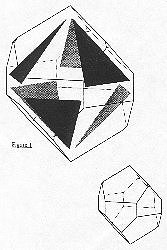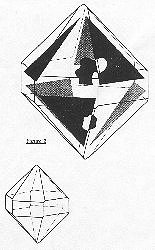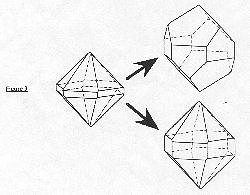During the April 1997 field trip to Mont Saint-Hilaire, I picked up some small samples because they contained a yellow platy material. When I finally cleaned them up recently, the yellow material turned out to be calcite, and rather badly banged up at that. But, as often happens with material from the Magic Mountain, there was an unexpected benefit. The calcite was sitting on nice little quartz crystals, partly colorless and partly smoky.
It quickly became apparent that the smoky regions of these crystals are not random, but are typically triangular in shape and occur in the same places on each crystal. They are located under alternating faces of the terminal rhombohedra. Furthermore, they occur at a slight depth in the crystal, being covered with more clear quartz, and have a clearly discernible flat lower surface.

Most of the crystals have on set of rhombohedral faces very much larger than the other, as in Figure 1. The smoky regions occur below the smaller set of rhombohedral faces. Assuming that the morphology of this quartz conforms to the usual pattern, the large faces belong to the form {1011} and the small ones to {0111}. The smoky regions bear witness to a time when the terminations of the crystals were much more evenly developed, and the prisms quite short.
At that time, conditions of growth must have changed, with the faces beginning to grow at a faster rate that the faces, and therefore getting smaller through time. At the same time, the impurity which provides the smoky color (probably aluminium, if the coloration is related to radiation effects) was selectively incorporated into the part of the crystal resulting from growth on the faces. Later, the pigmentation ceased, but faster growth of the faces continued, leading to the present morphology. Growth on the prism faces appears to have been slowest of all.
A few crystals are decidedly different from the majority in that they still have very much of a hexagonal aspect, with six subequal terminal faces. These have a very interesting difference in their smoky zonation, shown schematically in Figure 2. Small zones of no color occur within the triangular smoky regions, and adjacent to these are small zones of color within the otherwise colorless regions under adjacent faces.

Slight changes in relief on the surfaces of the faces correspond to these color changes. These are regions of Dauphine twinning which can be thought of as a rotation of parts of the crystal structure about the axis through 60° compared to adjacent parts. Dauphine twinning is very common in quartz, and is usually a penetration type of twinning, in which some parts of what appears to be a single crystal have one orientation, and other parts have the other, 60° off. On the termination, Dauphine twinning has the effect of placing bits of a face (and the crystal underneath it) within an face, and vice versa. When the boundary between a twinned region and the rest of the crystal crosses an edge between two terminal faces, the identities of the faces “flip”: one has a bit a face within an face and, next to it, a bit of an face within a face. These twin domains can often be recognized by a thin wormy line on the crystal face, and sometimes by a different luster on either side of the line, reflecting different resistance to etching of and faces. In this case, the boundaries are also marked by the distribution of the smoky zones.
The connection between the presence of Dauphine twinning and the difference in habit is not coincidental, I think. In the absence of twinning, it is relatively easy for and faces to grow at different rates: new growth layers form and spread outward until they reach the crystal edges, but have no impact on adjacent faces. But when faces are part and part because of Dauphine twinning, a new growth layer formed within the faster growing region of a face can spread across the twin boundary into the region, maintaining the twinning but helping the face to grow faster that it otherwise would. The clincher is that these more hexagonal crystals are systematically larger than the ones which do not show evidence of twinning.

Thus, the beautiful little zones of smoky color not only decorate these crystals but reveal a great deal about their growth. They demonstrate that a substantial change of habit accompanied the incorporation of the coloring agent, that most of the crystals are untwinned but a few are Dauphine twins, that the twinned crystals grew differently from the untwinned ones because of the effect of twinning on the mechanism of crystal growth, and that they wound up larger and with a different habit as a result, Not a bad story for a few bits of smoky color in some crystals I didn’t even mean to collect!
NOTE – The sketches are not the greatest in clarity, and this is my fault not being able to render them as nice as they truly are.
